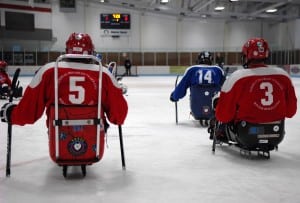
Winter sports, like hockey, are popular all around the globe, but especially in the upper Midwest where snow and ice are part of daily life for around five months of every year.
But, standard hockey, and ice sports in general, are not always the most conducive sports for players with disabilities.
Enter sled hockey.
Sled hockey is a great way for hockey fans with mobility limitations to get involved in the game they love.
Sled Hockey History
Developed by a physical rehabilitation center in Sweden in the 1960s, the game was first demonstrated at the Paralympic Games in 1976, in Sweden and first came to the United States, Minnesota specifically, in 1989.
Sled Hockey officially became a Paralympic Games event almost 20 years after the sport was first demonstrated at the games in 1994.
Who Can Participate?
Rules for participation are very broad, which allows a wide range of players to get involved in the game. The only requirement is that players have a permanent disability that prohibits them from playing stand up hockey. This includes, but is not limited to, players who are amputees, those who have spinal cord injuries or spina bifida, etc.
Equipment
Players wear a hockey helmet, gloves and body protection. They use a custom bucket seat sled fitted with two skate blades and two hockey sticks for propulsion, passing and shooting. The hockey sticks can be up to 100 cm long, but are generally between 75-95 cm in length.
Game Play
Each team has six players – three forwards, two defensive players, and a goalie. The high-paced game is played over three 20 minute periods and on a regulation sized ice rink with standard nets and pucks. Essentially, it’s the same as stand up hockey with the exception of sleds and using an extra stick.
Do you now or have you played Sled Hockey in the past? What was your experience? What advice do you have for people wanting to get involved?
